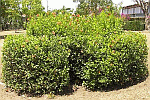
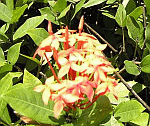
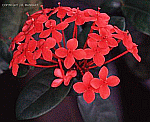
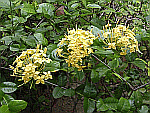

|
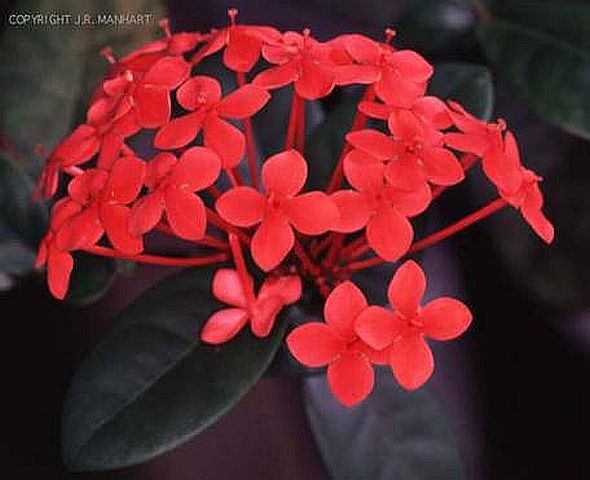
Ixora coccinea (J.R. Manhart, Texas)
Plant Family: Belongs to the Rubiaceae family, which includes the larger flowered, more vibrant, Ixora casei, the various coffee species (Coffea arabica, C. robusta, C. liberica) and the famous Noni, locally known as Pankila - a derivation of Painkiller, (Morinda citrifolia).
Description: A medium sized shrub, up to 9 ft tall (3 m); leaves simple, opposite, eliptical, smooth, green with lighter green in dry season, 8-12 cm long (3-5 in); flowers orange-red, born in terminal, dense, spherical bunches (corymbs), 8-10 cm wide (3-4 in ) and 5-8 cm tall (2-3 in), with numerous flowers in each bunch; individual flowers consist of a tubular corolla 5-8 cm long 2-3 in, topped by four acute lobes, about 1.5 cm long (0.6 in); flowers throughout year; fruit a roughly spherical berry, black when ripe; red, orange and yellow cultivars also available.
Natural Habitat: Well drained tropical soils in medium rainfall areas; propagation usually by cuttings, sometimes by seed.
Origin and Distribution: Originates in the East Indies; now widely distributed in tropics and variously in sub-tropics; common throughout Caribbean.
Uses: Primarily ornamental; cut specimens are long lasting and are often used in floral arrangements; sometimes used as a hedge; in tropical Asia, infusion of flowers and bark used for blood-shot eyes, leaves for sores and ulcers.
Indigenous Legends: Name "Ixora" derives from an Indian deity.
References:
Dan H. Nicolson. Flora of Dominica, Part 2: Dicotyledoneae. Smithsonian Institution, Washington, D.C. 1991
C.D. Adams. Flowering Plants of Jamaica. University of the West Indies, Mona, Glasgow University Press 1972
Lennox and S.A. Seddon. Flowers of the Caribbean. Macmillan, London 1978
H.F. Macmillan. Tropical Planting and Gardening. Macmillan, London 1956
US National Tropical Botanical Gardens. Kalaheo, Hawaii 2004 (ntbg.org)
Robert A. DeFilipps. Useful Plants of the Commonwealth of Dominica, West Indies. Smithsonian Institution, Washiungton, D.C. 1998
|



